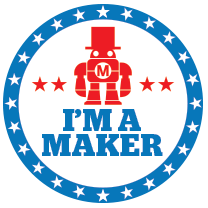Creating infographics is a great way to check for understanding because a well-crafted infographic requires you to drill down larger theories and the supporting research to key themes and concepts. In the past, I have designed infographics to make data more accessible and to share project information with a variety of audiences. This week, I worked to create an infographic (below) that could summarize the core ideas we have been exploring in CEP811, which focuses on the Maker Movement in education.
The theme that I chose to highlight with my infographic is the value of adding #MakerEd to your teacher toolbox. I wanted to recognize that many teachers already have numerous approaches and “tools” in their toolboxes that help them reach their students and make learning meaningful. I do not see the Maker Movement as something that can “rescue” education or solve all of its problems but I do believe that making is a powerful way for students to learn (Martinez & Stager, 2013, p. 3).
Therefore, it is important for educators to consider adding making to their toolboxes because it can help give students access to many of the experiences that help them to experience deeper learning. Likewise, #MakerEd can assist students in developing skills and mindsets that will serve them not only in the classroom, but in their futures as they start their own careers or even design completely new jobs (A. 2014).
Richard Culatta (2013) speaks to some of the challenges that many classrooms face today and I see the Maker Movement as helping to overcome them because it offers students a higher degree of voice and choice and through collaboration, hands-on learning, failure, and risk-taking, students begin to make connections about how things work and realize their own power as creators, inventors, and innovators (Couros, 2015).
If every lesson was designed with some form of making in mind, I think there would be a lot more cohesion across disciplines and room for real-world problem-solving in schools. Students would be able to constantly reference and build on their experiences because there would be fewer silos where students are told “this is science” and “this is literacy” and they are separate.
I am excited to see what the current generation of students create and how they change the world in the next few years, using everything from a Raspberry Pi to 3D printing skills.
(Click image to enlarge)













You must be logged in to post a comment.